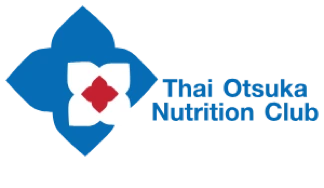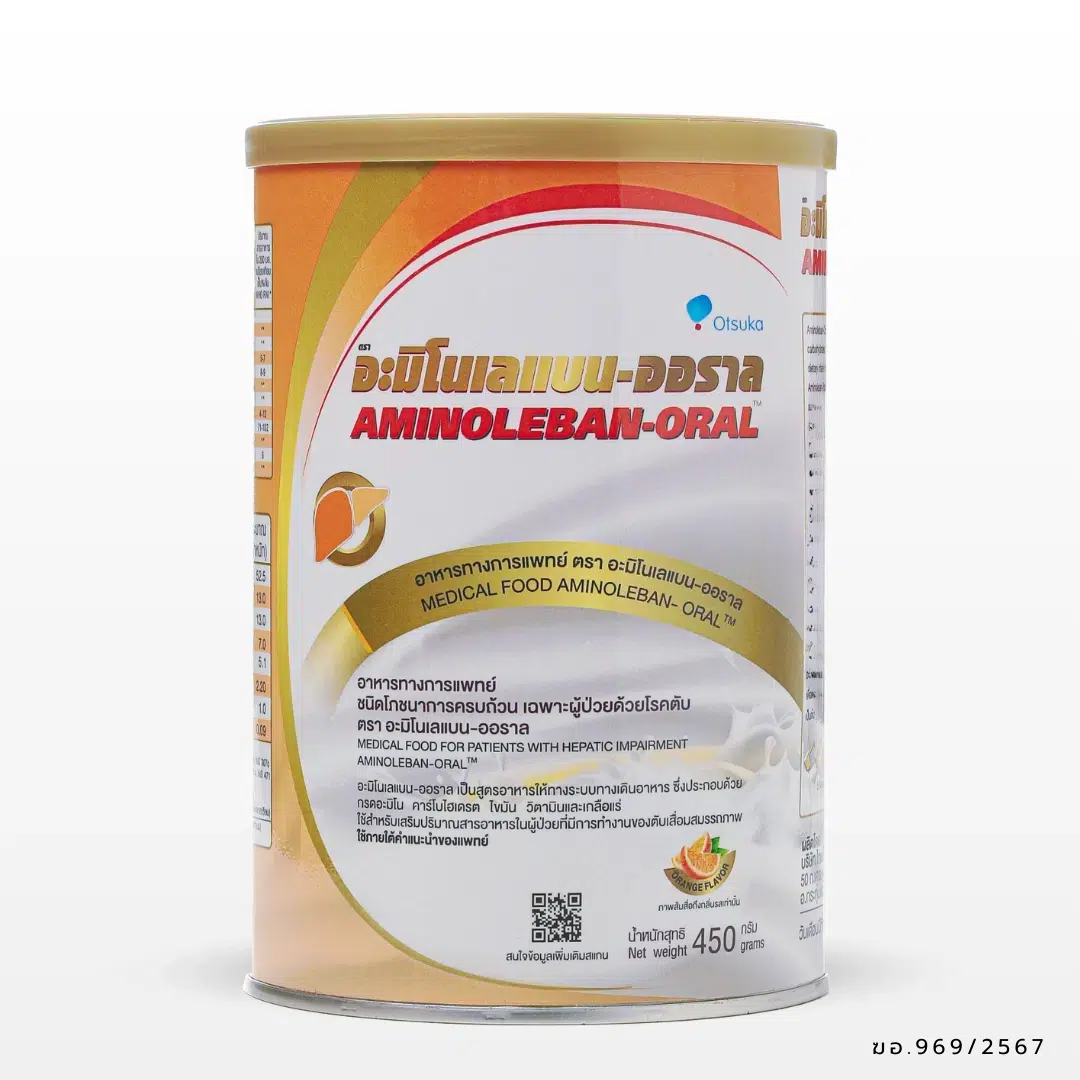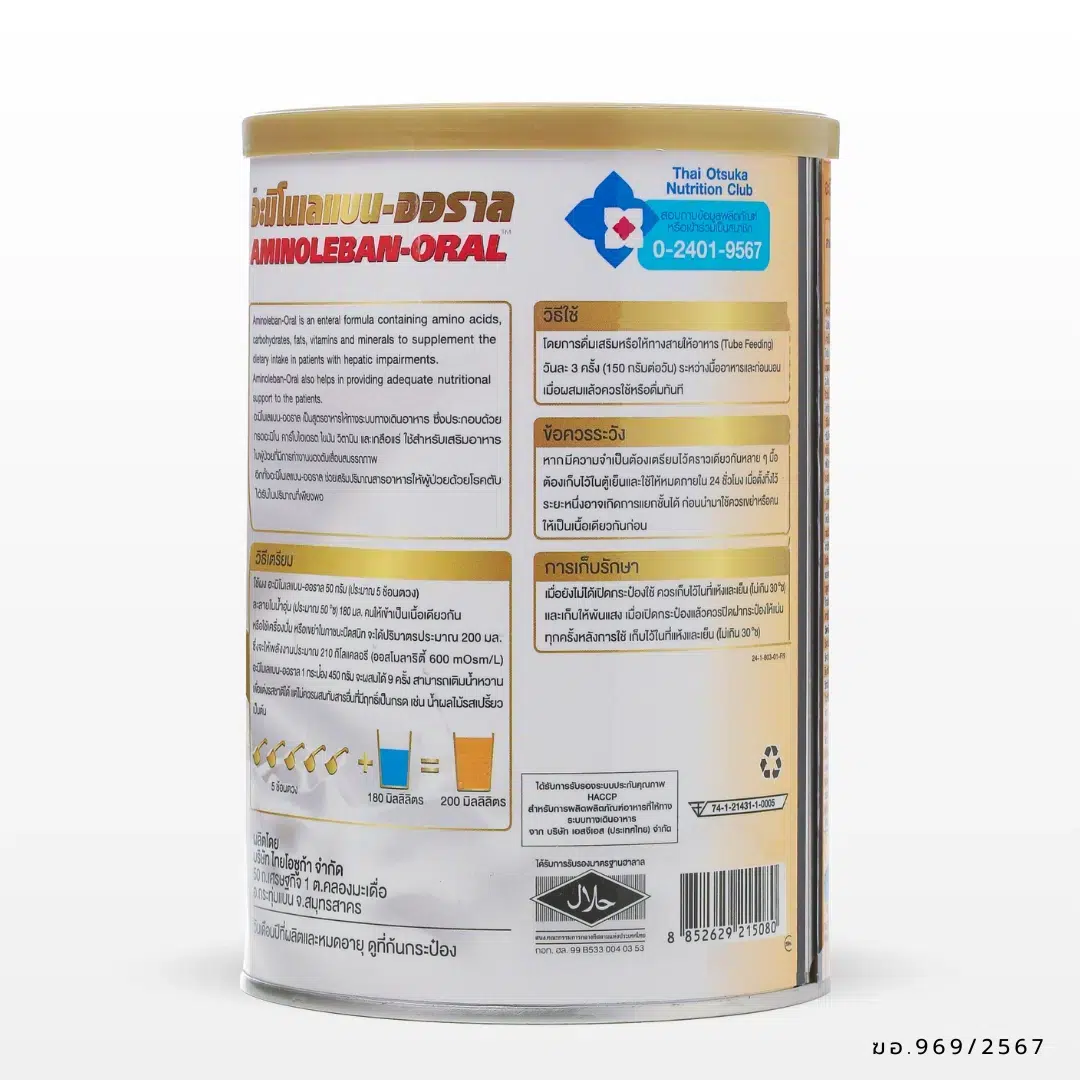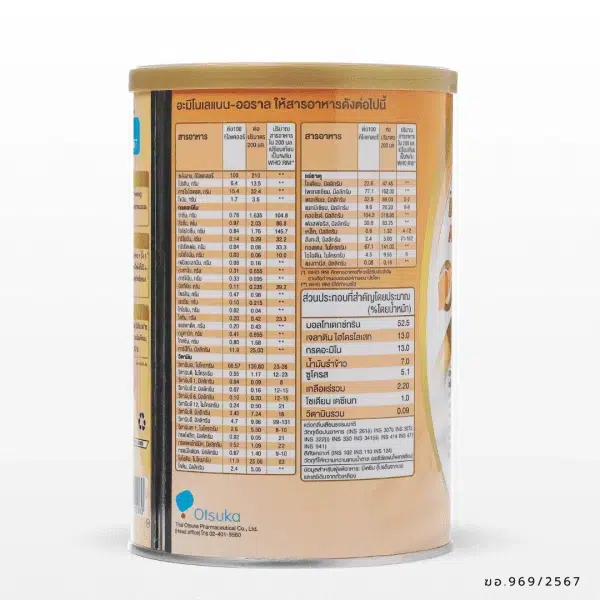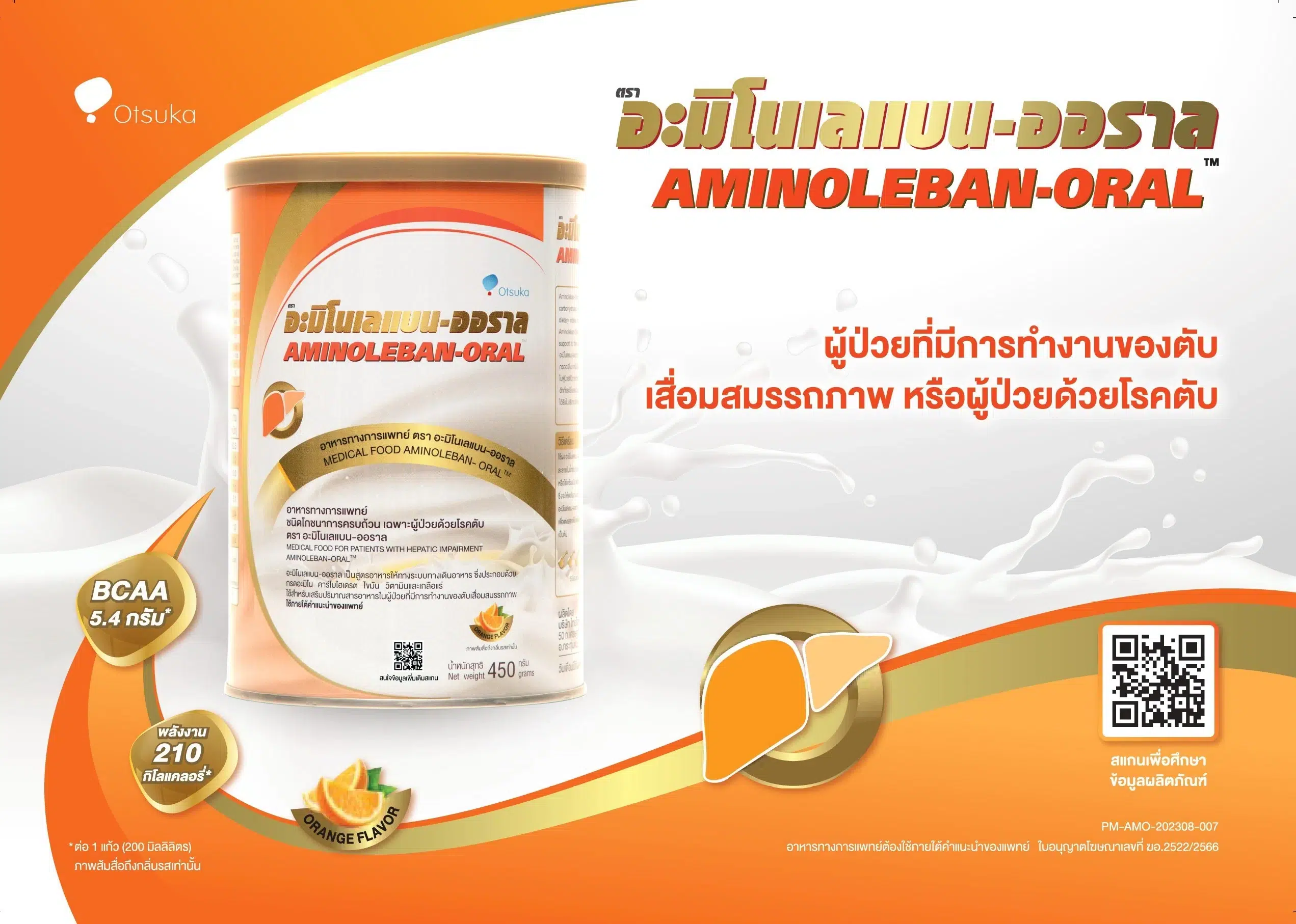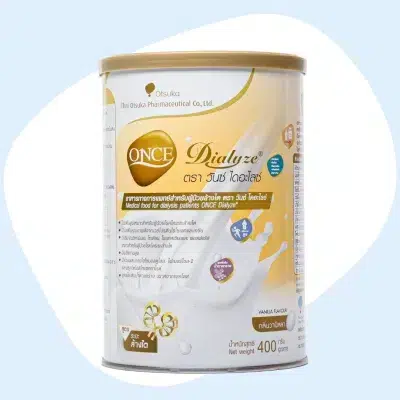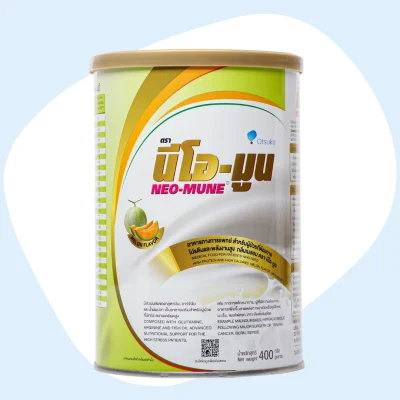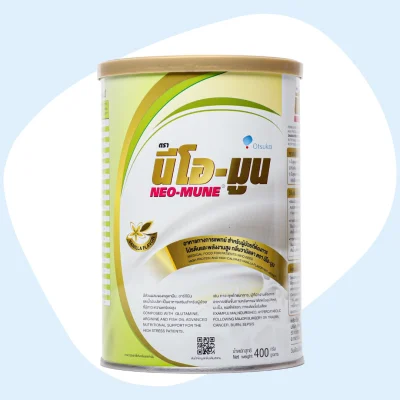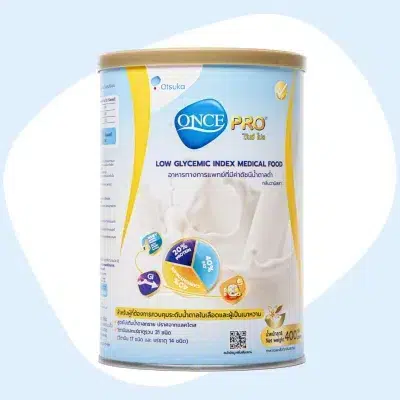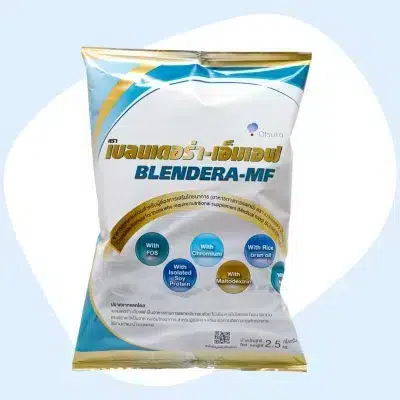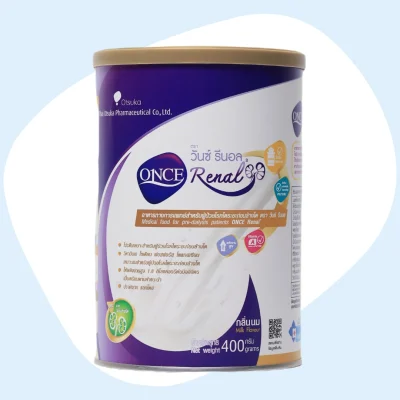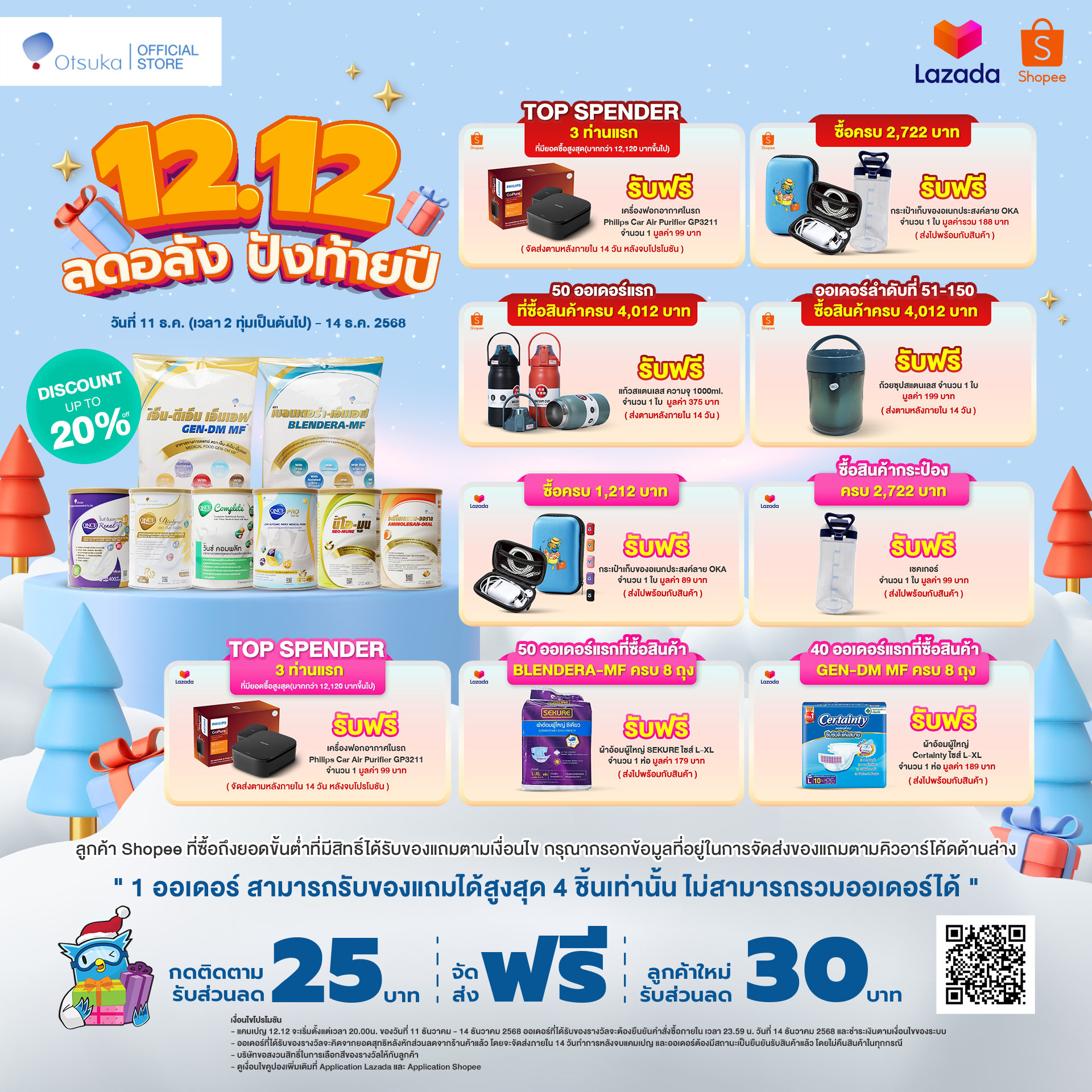AMINOLEBAN-ORAL™
AMINOLEBAN-ORAL
Medical food for patients with hepatic impairment
Orange Flavour Net weight 450 grams
Product Detail
AMINOLEBAN-ORAL is an enteral formula containing amino acids, carbohydrates, fats, vitamins and minerals to supplement the dietary intake in patients with hepatic impairments.
AMINOLEBAN-ORAL also helps in providing adequate nutritional support to the patients.
Medical food must be used under medical supervision.
Food Advertising no.1532/2565
Description
Description
Medical food must be used under medical supervision. Food Advertising no.1532/2565
Preparation
Preparation
Mix powder of AMINOLEBAN-ORAL 50 g (approximate 5 spoons) in 180mL lukewarm water (about 50๐C), stir by electric mixer or shake in closed container. The dissolved solution is about 200 mL, which supply energy about 210 Kilocalories (Osmolarity 600 mOsm/L).
1 can (450 g) of AMINOLEBAN-ORAL for consumption of 9 times
Syrup can be added for adjusting flavor but acidic ingredients such as sour fruit juice should not be mixed.
Instruction for use
By oral supplementation or tube feeding 3 times a day (150 g per day) during the meals and before bedtime. After mixing, the dissolved solution should be used immediately.
Precaution
If the large volume of product preparation for several meals is required, the prepared solution should be kept in the refrigerator and consumed within 24 hours.
Suspension and precipitation can be happened after preparation, the prepared solution can be homogeneous again by shaking before consumption.
Storage
Close the container tightly after opened and keep in the dry and cool place (not exceed 30๐C).
Once opened, the product should be consumed within 1 month.
Medical food must be used under medical supervision. Food Advertising no.1532/2565
Nutrition Fact
Nutrition Fact
| Nutrient | Per 100 kcal | Per 200 mL | Percent amount compared to RNI suggested by WHO(*) in 200 mL |
| Energy, kcal | 100 | 210 | ** |
| Protein, g | 6.4 | 13.5 | ** |
| Carbohydrate, g | 15.4 | 32.4 | ** |
| Fat, g | 1.7 | 3.5 | ** |
| Amino acids | |||
| Valine, g | 0.78 | 1.635 | 104.8 |
| Leucine, g | 0.97 | 2.03 | 86.8 |
| Isoleucine, g | 0.84 | 1.76 | 146.7 |
| Threonine, g | 0.14 | 0.29 | 32.2 |
| Tryptophan, g | 0.04 | 0.08 | 33.3 |
| Methionine, g | 0.03 | 0.06 | 10.0 |
| Phenylalanine, g | 0.08 | 0.16 | ** |
| Alanine, g | 0.31 | 0.655 | ** |
| Arginine, g | 0.33 | 0.695 | ** |
| Histidine, g | 0.11 | 0.235 | 39.2 |
| Proline, g | 0.47 | 0.98 | ** |
| Serine, g | 0.10 | 0.215 | ** |
| Tyrosine, g | 0.02 | 0.04 | ** |
| Lysine, g | 0.20 | 0.42 | 23.3 |
| Aspartic acid, g | 0.20 | 0.43 | ** |
| Glutamic acid, g | 0.41 | 0.855 | ** |
| Glycine, g | 0.80 | 1.68 | ** |
| Carnitine, mg | 11.9 | 25.00 | ** |
| Vitamins | |||
| Vitamin A, mcg | 66.57 | 139.80 | 23-28 |
| Vitamin D, mcg | 0.55 | 1.17 | 12-23 |
| Vitamin B1, mg | 0.04 | 0.09 | 8 |
| Vitamin B2, mg | 0.07 | 0.16 | 12-15 |
| Vitamin B6, mg | 0.10 | 0.20 | 12-15 |
| Vitamin B12, mcg | 0.24 | 0.50 | 21 |
| Vitamin C, mg | 3.45 | 7.24 | 16 |
| Vitamin E, mg | 4.7 | 9.86 | 99-131 |
| Vitamin K1, mcg | 2.6 | 5.50 | 8-10 |
| Folic acid, mg | 0.02 | 0.05 | 21 |
| Pantothenic acid, mg | 0.52 | 1.09 | 22 |
| Nicotinic acid, mg | 0.67 | 1.40 | 9-10 |
| Biotin, mcg | 11.9 | 25.00 | 83 |
| Choline, mg | 2.4 | 5.05 | ** |
| Minerals | |||
| Sodium, mg | 22.6 | 47.45 | ** |
| Potassium, mg | 77.1 | 162.00 | ** |
| Calcium, mg | 32.9 | 69.00 | 5-7 |
| Magnesium, mg | 9.6 | 20.20 | 8-9 |
| Chloride, mg | 104.3 | 218.95 | ** |
| Phosphorus, mg | 39.9 | 83.75 | ** |
| Iron, mg | 0.60 | 1.32 | 4-12 |
| Zinc, mg | 2.4 | 5.00 | 71-102 |
| Copper, mcg | 67.1 | 141.00 | ** |
| Iodine, mcg | 4.5 | 9.55 | 6 |
| Manganese, mg | 0.08 | 0.18 | ** |
(*) % of nutrients compared to recommended nutrient intake according to WHO criteria
(**) daily amount not established by WHO
Medical food must be used under medical supervision. Food Advertising no.1532/2565
Main Composition
Main Composition
| Main composition in approximate | % W / W |
| Maltodextrin | 52.5 |
| Gelatin hydrolysate | 13.0 |
| Amino acids | 13.0 |
| Rice bran oil | 7.0 |
| Sucrose | 5.1 |
| Total minerals | 2.204 |
| Sodium caseinate | 1.0 |
| Total vitamins | 0.094 |
Food Allergy
Contains casein (protein from milk) and soy
Remark
- Thai FDA food serial no. 74-1-21431-1-0005
- Manufacturer is certified HACCP for enteral nutrition products by SGS (Thailand) Limited
- Registration No. CICOT. HL. 99 B533 004 03 53
- Manufactured by: Thai Otsuka Pharmaceutical Co., Ltd 50, Sethakit 1 Road, Khlong Madua Kra Tum Ban, Samutsakorn, Thailand
Date of manufacture and expiry, see bottom of can
Medical food must be used under medical supervision. Food Advertising no.1532/2565
FAQ
FAQ
What nutrients does AMINOLEBAN-ORAL provide?
- High protein up to 25% includes
– BCAA (Branched Chain Amino Acid) 48% plays an important role that stimulates muscle protein synthesis, boosts immune system and improves symptoms of Hepatic Encephalopathy.
– Gelatin hydrolysate 48%
– Casein 4% is high quality protein, easily digested and absorbed
2. Fat
– Rice bran oil 100% provides completely essential fatty acid. As the patients with liver disease have problems in fatty metabolism, this ingredient is given in moderate amount in order that patients would acquire adequate essential fatty acid.
3. Carbohydrate
– Dextrin 90% great quality, easily digested and absorbed
– Sucrose 10% source of energy for patients and make the taste better.
4. Containing fat-soluble vitamin including A, D, E and K
5. Containing Zinc, of patients with liver disease lack
Why do Patients with liver disease have BCAA (Branched Chain Amino Acid) deficiency?
- Because the liver is responsible for the synthesis of BCAA , and because patients with liver illness consume protein and store half of it in the liver and half in the muscles, reduced functioning occurs, resulting in an inability to use nutrients as effectively as before.
• For the patients with liver disease, liver is unable to synthesize and store BCAA as well as before while the body need to utilise BCAA more. In order to get BCAA, this leads to an increase in muscle depletion. Patients with liver illness have less muscle mass and less BCAA stored in their muscles. As a result, the patients are deficient in BCAA.
What are the disadvantages of BCAA insufficiency in liver disease patients?
- It causes a drop in blood protein levels as well as a reduction in the body’s immunity system.
• It causes a rise in protein depletion in muscles and other organs, resulting in reduced muscles in the arms and legs, atrophy, and increased fatigue.
• It increases AAA (Aromatic Amino Acids) in the body, which enter the brain more than BCAA, which causes an imbalance of neurotransmitters in the brain, which causes dementia from a liver illness known as Hepatic Encephalopathy.
How to drink AMINOLEBAN-ORAL. It is recommended to drink as a dietary supplement
- Mix 5 spoons (50g) with 200 ml water. A glass will give 210 kilocalories which contains 13.5 g of protein.
*The portion can be adjusted depending on the amount of energy required per day.
- Mix the powder with warm water to drink or feed through a tube three times a day, at brunch, afternoon, and before bed (MOST IMPORTANT)
Brief properties of AMINOLEBAN-ORAL
- A medical food rich in essential nutrients, ideal for people suffering from liver disorders such as cirrhosis, cancer, or Hepatic Encephalopathy.
• Contains BCAA that help raise protein levels and promote the balance of brain chemicals in patients.
• Reduces protein and energy deficiency in liver disease patients
• Improves the quality of life for patients with liver diseases
• Reduce the rate of death from liver illness
Limitation to the use of AMINOLEBAN-ORAL
Patients with amino acid metabolism disorders
Why does AMINOLEBAN-ORAL taste unfavorable ?
The amino acid, which is an important nutrient, causes an unpleasant taste. It is recommended that you mix it with something sweeter or your favorite beverage.
*Caution* Avoid mixing with any other acidic beverage, such as citrus juice.
How many sizes is AMINOLEBAN-ORAL available in? What is the shelf life of this product?
AMINOLEBAN-ORAL is formulated as power and offered in 450 g packaged in can.
*The product has a two-year shelf life.
For whom is the AMINOLEBAN-ORAL deal?
1.Patients suffering from liver disease and severe liver disorder
2. Patients suffering from liver cirrhosis
3. Patients suffering from liver cancer
4. People with cerebral symptoms due to liver disease
Tips that you need to know about AMINOLEBAN-ORAL
High temperature water may cause any change of protein structure (protein denaturation)
Medical food must be used under medical supervision. Food Advertising no.1532/2565
